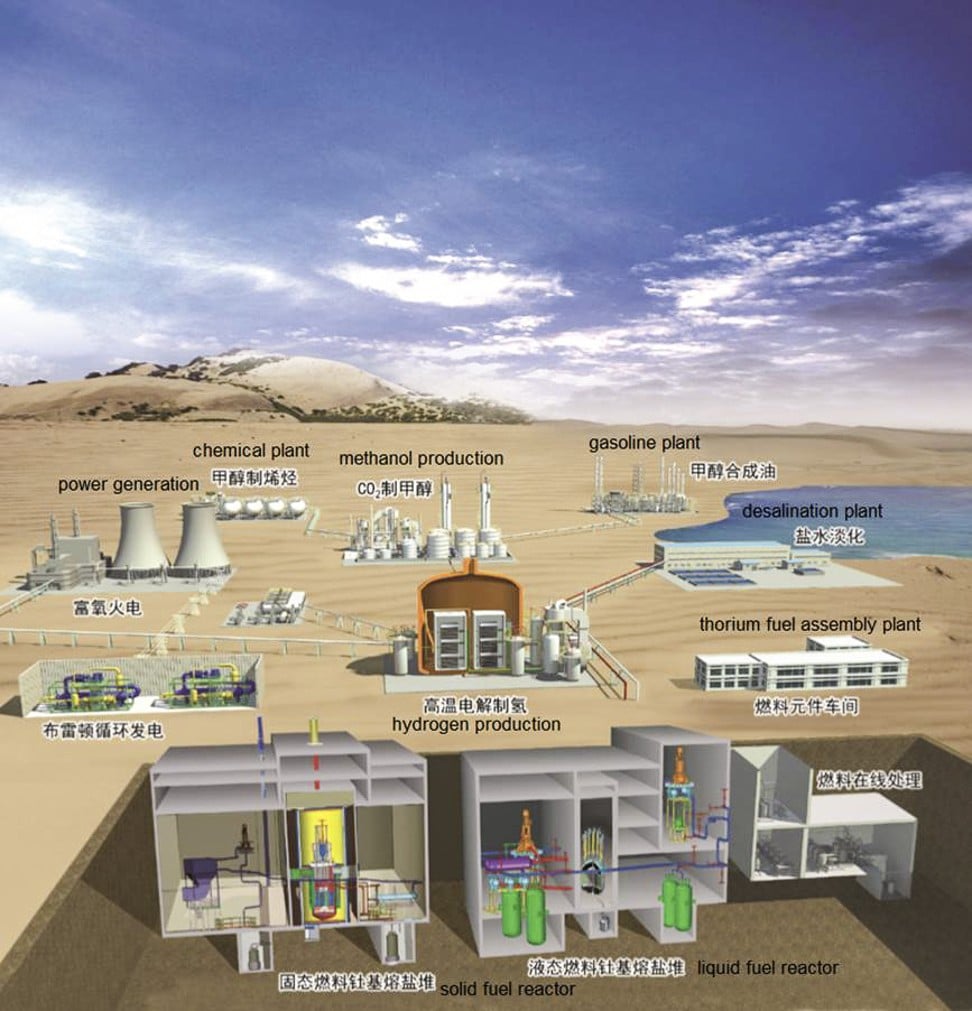Molten Salt Reactor
Beijing pumping billions into the development of ‘molten salt’ reactors, amid revived interest among nations in the potentially safer and more powerful technology.
China is to spend 22 billion yuan (US$3.3 billion) trying to perfect a form of technology largely discarded in the cold war which could produce a safer but more powerful form of nuclear energy.
The cash is to develop two “molten salt” reactors in the Gobi Desert in northern China. Researchers hope that if they can solve a number of technical problems the reactors will lead to a range of applications, including nuclear-powered warships and drones.


Beijing pumping billions into the development of ‘molten salt’ reactors, amid revived interest among nations in the potentially safer and more powerful technology.
China is to spend 22 billion yuan (US$3.3 billion) trying to perfect a form of technology largely discarded in the cold war which could produce a safer but more powerful form of nuclear energy.
The cash is to develop two “molten salt” reactors in the Gobi Desert in northern China. Researchers hope that if they can solve a number of technical problems the reactors will lead to a range of applications, including nuclear-powered warships and drones.
The technology, in theory, can create more heat
and power than existing forms of nuclear reactors that use uranium,
while producing only one thousandth of the radioactive waste.
It also has the advantage for China of using
thorium as its main fuel. China has some of the world’s largest reserves
of the metal.
China is not alone in trying to revive the
technology because of the potential benefits. Companies in the United
States are working in the field, while Japan, Russia and France have all
expressed renewed interest in the technology.
The Chinese project has been funded by the
central government and the two reactors are to be built at Wuwei in
Gansu province, according to a statement on the website of the Chinese
Academy of Sciences. The lead scientist on the project is Jiang Mianheng
– the son of the former Chinese president Jiang Zemin – and it is hoped
the reactors will be up and running by 2020.
The US air force built a 2.5-megawatt molten
salt reactor in the 1950s as part of a programme to develop
nuclear-powered aircraft engines.
The reactors use molten salt rather than water
as a coolant, allowing them to create temperatures of over 800 degrees
Celsius, nearly three times the heat produced by a commercial nuclear
plant fuelled with uranium. The superhot air had the potential to drive
turbines and jet engines and in theory keep a bomber flying at
supersonic speed for days.
The US project was shelved in the 1970s.
Problems were encountered trying to reduce the size and weight of the
reactor, and there were public concerns over the safety of the
technology when placed in an aircraft.
Another problem was the erosion to pipes and the reactor chamber caused by the hot salt used in the fission process.
Yan Long, a researcher involved in the Chinese
project at the Shanghai Institute of Applied Physics, said the Gansu
facility might eventually help China develop a thorium-powered warship
or aircraft.
He said it was now possible to build a very
small molten salt reactor and that after years of research and
government funding, scientists had developed special alloy and coating
materials to prevent chemical corrosion.
The reactors in Gansu were designed to demonstrate the feasibility of the technology, he said.

The
Convair NB-36H Peacemaker experimental aircraft was part of the US’s
Nuclear Aircraft Programme in the 1950s. Photo: Wikimedia Commons
The research facility in Gansu will be built by a lake with high salt levels, according to the project blueprints.
Both reactors will be underground and the heat
they generate will reach 12 megawatts. The heat will be channelled to a
power generation plant, several factories and a desalination plant by
the lake to produce electricity, hydrogen, industrial chemicals,
drinking water and minerals.
After the experiment, China may move on to commercial or military use of the technology on a larger scale, Yan said.
“We are now developing new materials for
warships. The materials must come with relatively low cost for mass
production and they must be compact and light, otherwise the reactor
won’t fit in a ship,” he said.
Chen Fu, a thermal physicist at the Harbin
Institute of Technology involved in the development of new power
generation systems for China’s navy, said the heat generated by a
thorium molten salt reactor could be perfect to help generate power on a
warship.
“It should be able to generate enough electricity for propulsion and electric equipment on an aircraft carrier,” he said.
Chen said the higher the temperature, the higher
the power generation efficiency – a thorium-powered carrier could
operate faster and longer than existing carriers using uranium as fuel.
“But the ship will need a very different
structure to accommodate the new power source. It will be a difficult
and tricky job because the rest of the ship must be strengthened to
handle the increased power,” he said.

Artist impression of the molten salt reactor.
A military drone researcher in Beijing said a
molten salt reactor could be used on a new generation of large,
endurance drones operating at very high altitudes because it could be
made very small and its operation did not require water.
“These drones would stay aloft over the oceans
such as the Pacific. They would serve as a platform for surveillance,
communication or weapon delivery to deter nuclear and other threats from
hostile countries,” said the researcher, who asked not to be named.
“A nuclear-powered drone may be technically more
feasible than manned aircraft because it does not require building a
cockpit with lead to protect the human crew from radiation. It will also
have more public acceptance. If an accident happens, it crashes into
the sea,” the person said.
Yan said, however, that the aircraft research
project still faced many challenges. To mount a reactor on an aircraft
would require ultralight, super-strong materials which were still under
development in the laboratory.
“This is where the Americans have failed,” he said.


Post a Comment Blogger Facebook Disqus